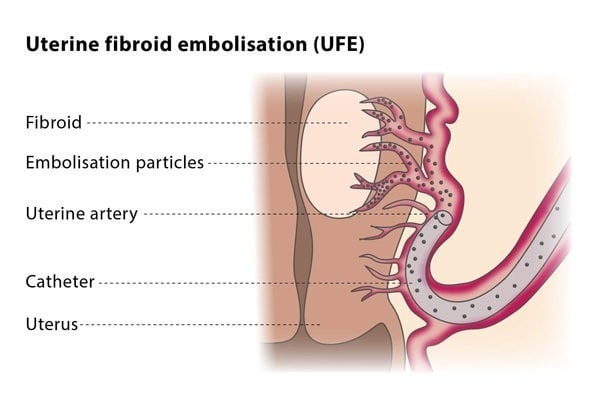What is uterine fibroid embolization?
Uterine fibroids are benign gynaecological tumours. If a patient suffers fibroid-related clinical symptoms such as long and heavy menstruations or pelvic pain, fibroid treatments can be performed. Uterine fibroid embolization is a minimally invasive procedure which aims to relieve the symptoms by preventing blood flow to the fibroids.
How does the procedure work?
Once you arrive at the hospital, You will be asked to remove your clothes and put on a hospital theatre gown. A bladder catheter will be inserted. UFE can be painful, therefore multiple painkillers will be given to you before, during and after the procedure. You may be given some sedation during the procedure as well.
The aim of the procedure is to stop blood flowing into the vessels which supply the fibroids whilst preserving blood flow to the surrounding area.
Usually the embolization is carried out under local anaesthesia during a short stay in hospital.
A catheter is threaded through the artery to the uterus while the interventional radiologist guides the procedure with the help of a moving X-ray (fluoroscopy). X-ray “dye” is injected into the catheter to visualize the blood supply to the fibroids. You will feel a momentary hot flush in your pelvis. It will “tweak” your bladder and make you feel as if you have wet yourself, this will last a few seconds. As the uterine artery is accessed you may feel further tiny hot flushes as the radiologist injects a small amount of the “dye” to visualize the vessel.
After identifying abnormal arteries supplying blood to the fibroids, the interventional radiologist injects tiny particles the size of grains of sand into the artery. This cuts off the blood flow and causes the tumour (or tumours) to shrink. The artery on the other side of the uterus is then treated. The skin puncture where the catheter was inserted is cleaned and covered with a bandage.
How long will it take?
Every patient’s situation is different, and it is not always easy to predict how complex or how straightforward the embolization will be. Some uterine fibroid embolizations do not take very long, perhaps an hour. Other embolizations may be more involved and take longer, perhaps two hours. Expect to be in the radiology department for two hours.
What will happen afterwards?
Fibroid embolization usually requires a short hospital stay. Pain-killing medication and medication that controls swelling are typically prescribed following the procedure to treat cramping and pain. Fever sometimes occurs after embolization and is usually treated with paracetamol (acetaminophen). Many women resume light activity after a few days and the majority of women are able to return to normal activity within one or two weeks.
You will have to see your IR for a check-up one month and six months after the procedure. A control MRI will probably be prescribed after three or six months.

